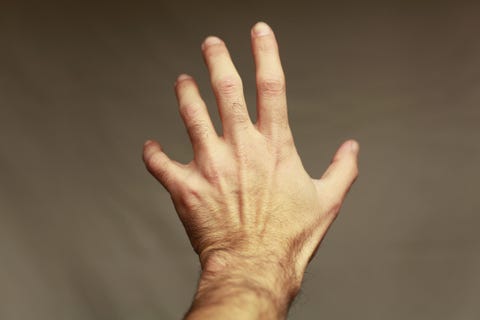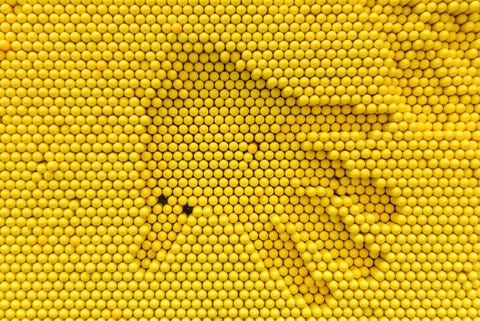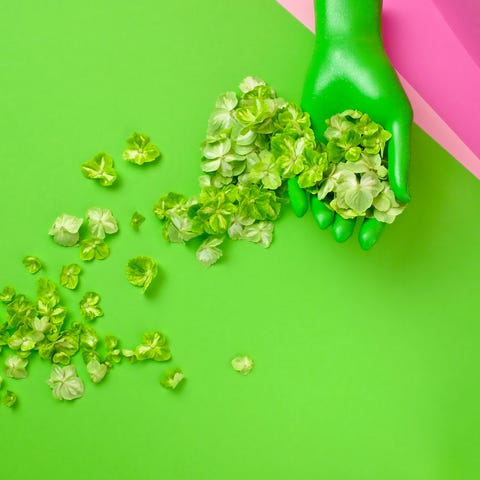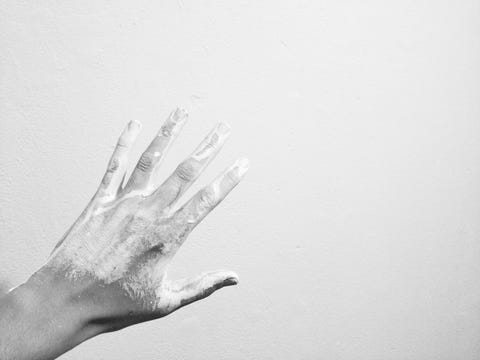It sounds weird but funky-colored toenails have a way of being less alarming than discolored fingernails (after all, when was the last time you washed your feet?).
But just because you’re keeping your hands clean doesn’t mean white lines, spots, or changes won’t occur. Sometimes, changes in fingernail color are no biggie (the result of a minor injury). Other times, they signal a more serious issue (melanoma).
Healthy fingernails are smooth, uniform in color, and free of spots or discoloration. Take a look at your paws. See any of the below changes? Allow docs to explain what might be going on — and what to do about it.
If your fingernails are brown or black…

Getty ImagesRiccardo Botta / EyeEm
“If your nail is brown or black, the most important thing to worry about is a nail melanoma,” (a.k.a. the most serious form of skin cancer), says Shari Lipner, M.D., Ph.D., a dermatologist and director of the nail division at Weill Cornell Medicine. “While nail melanomas are uncommon, they can be deadly if not diagnosed and treated early.”
If you notice pain, bleeding, or splitting of the nail, make an appointment with a board-certified dermatologist who may have to do a biopsy on the nail, she says.
An especially concerning sign? If the skin surrounding the lower part of your nail turns brown or black — this heightens suspicion for a melanoma, says Meghan Feely, M.D., a board-certified dermatologist based in New York City and New Jersey and clinical instructor at Mount Sinai. It’s known as Hutchinson’s sign, and it most commonly occurs on your thumb (or big toe), according to The New England Journal of Medicine. (Warning: It’s not pretty.)
While a brown or black band of pigment in one or more nails could also simply be a benign mole, it’s best to book a visit to the derm just in case, Feely notes.
Other reasons for a black or brown nail aren’t so scary: fungal infections (this would be accompanied by yellowing and thickening of the nail); bacterial infections; or even a funky response to medication. For example, chemotherapy drugs can turn fingernails gray-brown, for example, Lipner says.
If your fingernails are yellow…

Getty ImagesWeerayut Ranmai / EyeEm
“A yellow nail may be a sign of a fungal infection or the skin condition psoriasis,” Lipner says.
Nail psoriasis often comes with salmon-colored discoloration called “oil drops,” as well as nail pitting, which is when the nail appears to have been dented by tiny ice picks, Feely explains. Usually, nail psoriasis appears years after psoriasis first shows up on the skin, according to the American Academy of Dermatology. Not already being treated for psoriasis? Visit a dermatologist for a solid diagnosis.
If you have a fungal infection, discoloration starts small — a white or yellow spot under the tip of your fingernail, for example. But as the infection digs in, your nail can begin to thicken, crumble at the edges, and even smell a bit foul. The fix? Oral or topical antifungal medications, Lipner says.
See bands of yellow streaks on your fingernails? This could be a rare tumor of the nail matrix which can be surgically removed, Feely says. Make sure to see a derm for a full workup.
And if your fingernails are very yellow…
If a lot of your fingernails are yellow, and they seem to have thickened, curved, or even started to detach from the nail bed, this could be a sign of an extremely rare condition called yellow nail syndrome, which is when your arms and legs swell up due to a buildup of a fluid called lymph, according to the National Organization for Rare Disorders (NORD).
The exact cause of yellow nail syndrome isn’t clear, though it comes with respiratory tract abnormalities and breathing issues, so get yourself to a doctor ASAP.
If your fingernails are green…

Getty ImagesJuj Winn
Nails have you looking like a swamp creature? Chances are you’ve got a bacterial nail infection. Bacteria called Pseudomonas aeruginosa cause blue-green discoloration of the nail plate, commonly in people whose hands are often in freshwater, says Feely. These bacteria thrive in warm, wet environments which means they’re found all over the great outdoors and potentially in the jacuzzi, too.
Typically, this nail infection isn’t painful — just a bit swollen and unsightly. The fix? A visit to the doctor for oral or topical antibiotics, Lipner says.
If your fingernails are purple, blue, or red…

Getty ImagesRath Phngs’ Mu Lnxy Su / EyeEm
Purple nail? If you stubbed it, don’t panic. “A purple nail is most likely blood that is trapped between the nail plate and the underlying nail bed,” Lipner says, which can occur after trauma to the nail (a.k.a., a pool ball hit your nail). Usually, this issue will go away with time and additional nail growth, but if you’re in some serious pain, you may have to have your nail drained.
Another possibility? A glomus tumor, a rare (but benign) tumor below the nail plate that can appear purple, red, or blue and is less than two centimeters in size (think: the width of two pencils). If you have one, it could feel tender and sensitive to cool temperatures, Feely says. Think this could be the case? Head to your dermatologist for an ultrasound or MRI scan to assess the tumor, which can then be surgically removed, Feely says.
If your fingernails are blue…

Getty ImagesNorman Posselt
While a blue nail may signify that underlying glomus tumor, blue nails could also be a sign of cyanosis — when red blood cells are not carrying enough oxygen, Lipner says. This could be linked to lung or heart issues, like asthma, pneumonia, or poor circulation. Another possible cause? Silver exposure (think: frequent exposure to a hazardous waste site or contaminated drinking water — not from the ring on your finger).
In either case, the course of action is the same: Get yourself to a doctor to figure out the underlying cause.
If your fingernails are white…

Getty ImagesGeorgina Kois / EyeEm
Got patches of white on your nails? “A white nail is most commonly caused by trauma,” Lipner says.
In particular, “Mees’ lines” — white lines that run across the nail plate, and that can be associated with arsenic or thallium exposure, congestive heart failure, kidney failure, or certain drugs, Feely says. Other times, white nails can occur from infections due to fungi, molds, and yeast. That’s why the best thing to do is to see a doctor to figure out the underlying cause.
If your fingernails are half white and half pink, red, or brown…

Getty Imageseskaylim
Little-half moons of white at the base of your nails are normal, but when that moon extends halfway up the nail bed followed by a pink, red, or brown band, you could have a rare condition called half and half nails, a sign of poor kidney function. What to do? Head to the doctor for a medical workup, as this could be a sign of kidney damage, failure, or disease.
Source: Read Full Article
